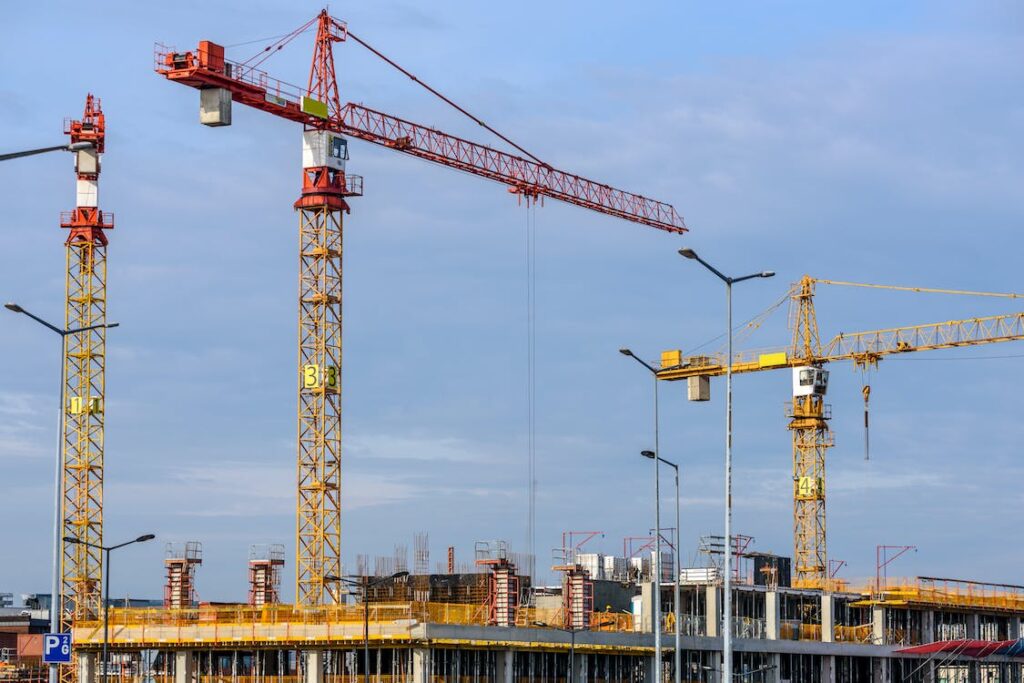Climate change is no longer a distant threat; it’s a reality that the world is grappling with today. The consequences of rising global temperatures, extreme weather events, and environmental degradation are becoming increasingly evident. In this evolving landscape, industries of all kinds are reevaluating their practices and embracing sustainability as a fundamental principle. The construction industry, known for its resource-intensive nature, is no exception. In this blog, we will explore the profound impact of climate change on modern construction practices and how the industry is adapting to build a more sustainable and resilient future.

Climate Change: A Global Challenge
Before we delve into the role of climate change in shaping construction practices, it’s essential to understand the global climate context we are facing today.
Rising Global Temperatures
One of the most prominent and alarming aspects of climate change is the relentless and steady increase in global temperatures. This temperature rise is not just a recent anomaly but a clear and relentless trend that scientists have been monitoring for decades. The Earth’s average temperature is inexorably climbing, and the consequences of this warming are felt across the planet.
This unwavering trend is primarily attributed to the accumulation of greenhouse gases in the Earth’s atmosphere. These gases, such as carbon dioxide (CO2), methane (CH4), and nitrous oxide (N2O), act like a thermal blanket, trapping heat from the sun within our atmosphere. As a result, the Earth’s natural equilibrium is disrupted, leading to the phenomenon commonly referred to as the greenhouse effect.
While some of these gases are naturally occurring, the rapid and unprecedented increase in their concentrations is predominantly attributed to human activities. The burning of fossil fuels for energy, transportation, and industrial processes releases substantial amounts of CO2 and CH4 into the atmosphere.
Additionally, deforestation and land-use changes contribute to elevated greenhouse gas levels. The ramifications of these human-induced activities are dire, as they exacerbate the greenhouse effect and drive global temperatures to rise at an accelerated pace. Consequently, the urgency to address climate change and its profound impact on various aspects of our lives, including construction practices, has never been more evident.
Extreme Weather Events
Climate change has amplified the frequency and intensity of extreme weather events, including hurricanes, floods, droughts, and wildfires. These events can wreak havoc on communities and infrastructure, causing immense economic and human losses.
Sea-Level Rise
As global temperatures rise, polar ice caps and glaciers are melting, contributing to sea-level rise. This phenomenon threatens coastal areas, displacing communities and posing significant challenges to infrastructure resilience.
Biodiversity Loss
Climate change is driving biodiversity loss, disrupting ecosystems and the services they provide. This can impact construction projects by affecting local environments and necessitating adjustments to development plans.
The Impact of Climate Change on Construction
Climate change has profound implications for the construction industry. Here are some of the key ways in which it is shaping modern construction practices:
Increased Vulnerability to Extreme Weather
Construction sites are vulnerable to the impacts of extreme weather events, such as heavy rainfall, hurricanes, and flooding. These events can lead to delays, damage to equipment and materials, and increased safety risks for workers. In response, construction practices are evolving to incorporate climate resilience measures.
Changing Environmental Regulations
Governments worldwide are responding to the pressing challenges of climate change by taking decisive actions to curb greenhouse gas emissions and promote environmental sustainability. These actions manifest in the form of increasingly stringent and comprehensive environmental regulations that affect a wide array of industries, including construction.
Recognizing the pivotal role that the construction sector plays in resource consumption and emissions, governments are now implementing a suite of measures aimed at reducing its environmental footprint. These regulations encompass a multifaceted approach that encompasses various facets of construction practices.
First and foremost, they often mandate the utilisation of eco-friendly building materials that have a reduced environmental impact throughout their life cycle, from production to disposal. These materials may include recycled and sustainable resources, which not only minimise the consumption of finite resources but also lower carbon emissions associated with their production.
Furthermore, governments are pushing for energy-efficient designs that prioritise reduced energy consumption and lower carbon emissions throughout a building’s operational life. These designs frequently entail the integration of renewable energy sources, advanced insulation techniques, and innovative HVAC systems, all of which contribute to diminished reliance on fossil fuels and a smaller carbon footprint. Sustainable construction practices, such as minimising waste generation and maximising recycling, are also emphasised in these regulations, aligning with the broader objective of promoting a circular economy.
As governments continue to elevate the stringency of these environmental regulations, construction projects are compelled to adopt a holistic approach to sustainability, thus reshaping the industry towards a more environmentally conscious and responsible future.
Energy Efficiency and Carbon Footprint
Buildings are significant contributors to greenhouse gas emissions due to their energy consumption. Modern construction practices emphasise energy-efficient designs, renewable energy integration, and improved insulation to reduce a building’s carbon footprint.
Sustainable Materials
The construction industry is increasingly adopting sustainable and eco-friendly building materials. This includes using recycled materials, responsibly sourced wood, and low-impact products to reduce resource consumption and environmental impact.
Resilient Infrastructure
Infrastructure projects, including roads, bridges, and utilities, are being designed with climate resilience in mind. Engineers are considering factors such as sea-level rise, extreme heat, and changing precipitation patterns when planning and building infrastructure.
Green Building Certification
Green building certification programs, such as LEED (Leadership in Energy and Environmental Design) and BREEAM (Building Research Establishment Environmental Assessment Method), are becoming more popular. These programs recognize and promote sustainable construction practices.
Sustainable Construction Practices in Response to Climate Change
As the construction industry faces the challenges posed by climate change, it is embracing sustainable practices to mitigate its impact and contribute to environmental preservation. Here are some notable sustainable construction practices being adopted:
Passive Design and Energy Efficiency
Modern buildings are designed with passive strategies to minimise energy consumption. These include maximising natural light, optimising insulation, and incorporating efficient heating, ventilation, and air conditioning (HVAC) systems.
Renewable Energy Integration
Solar panels, wind turbines, and other renewable energy sources are integrated into building designs to reduce reliance on fossil fuels and lower greenhouse gas emissions.

Green Roofs and Walls
Green roofs and walls are installed to enhance insulation, absorb rainwater, and provide natural habitats in urban environments. They contribute to improved air quality and reduced heat island effects.
Rainwater Harvesting and Greywater Recycling
Rainwater harvesting systems collect and store rainwater for non-potable uses, such as irrigation and toilet flushing. Greywater recycling systems treat wastewater from sinks and showers for reuse, further reducing water consumption.
Low-Impact Materials
Builders are selecting materials with low environmental impact. This includes using recycled and reclaimed materials, reducing waste during construction, and opting for products with lower embodied carbon.
Modular and Prefabricated Construction
Modular construction reduces waste and energy consumption by optimising the use of materials and streamlining construction processes. It also allows for greater control over indoor environmental quality.
Resilient Landscaping
Landscaping designs are adapted to withstand changing climate conditions, including drought-resistant plants, permeable paving, and flood-resistant vegetation.
Sustainability in Construction
The Edge, Amsterdam, Netherlands
The Edge, a sustainable office building in Amsterdam, has been dubbed the “greenest building in the world.” It features a range of innovative sustainability measures, including a smart lighting system that adjusts to daylight levels, rainwater harvesting for toilet flushing, and an energy-efficient design that incorporates solar panels and energy-efficient HVAC systems.
One Angel Square, Manchester, UK
One Angel Square is the headquarters of the Co-operative Group and has achieved the highest BREEAM score ever awarded to an office building. It incorporates numerous sustainable features, including a combined heat and power (CHP) plant, rainwater harvesting, and energy-efficient building materials.
The Bullitt Center, Seattle, USA
The Bullitt Center is a commercial office building that aims to meet the Living Building Challenge, one of the most rigorous sustainability certifications. It features composting toilets, rainwater harvesting, and an energy-efficient design that generates more electricity than it consumes.
An Outlook For Sustainable Construction Moving Foward
The construction industry’s response to climate change is evolving, and its commitment to sustainability continues to grow. As we look to the future, several trends and innovations are likely to shape the industry further:
Zero-Energy Buildings
The concept of zero-energy buildings, which produce as much energy as they consume, will become more widespread. Advancements in energy-efficient technologies and renewable energy sources will drive this trend.
Circular Economy Practices
Construction companies will increasingly adopt circular economy principles, focusing on reducing waste, reusing materials, and recycling construction debris.
Advanced Building Technologies
Emerging technologies such as Building Information Modeling (BIM), 3D printing, and artificial intelligence will enhance construction efficiency and sustainability.
Climate-Responsive Design
Architects and engineers will prioritise designs that respond to local climate conditions, incorporating features like passive cooling and natural ventilation.
Resilience and Adaptation
Resilient construction practices will become standard to protect buildings and infrastructure from climate-related risks. This includes elevating structures to mitigate flooding and using resilient materials.
Community and Ecosystem Integration
Construction projects will increasingly consider their impact on surrounding communities and ecosystems, aiming to enhance biodiversity and improve the overall well-being of residents.
Climate change is fundamentally reshaping modern construction practices, challenging the industry to adopt more sustainable and resilient approaches. As we confront the pressing need to reduce carbon emissions and adapt to changing environmental conditions, construction professionals are playing a crucial role in shaping a sustainable future.
The integration of sustainable materials, energy-efficient designs, and climate-resilient strategies not only mitigates the industry’s impact on the environment but also enhances the quality, durability, and efficiency of constructed buildings and infrastructure. As the construction sector continues to evolve and embrace sustainability, it contributes to global efforts to combat climate change and build a more resilient and sustainable world for generations to come.
A good construction software makes use of good project management functionality, estimate and financial/accounting tool functionality, job management, scheduling and planning and support functionalities and more. WunderBuild is a construction management software that aims to provide all of these functionalities and more to bring out the best outcomes for a project. Enquire here today, to learn more about Wunderbuild and start your free trial.




